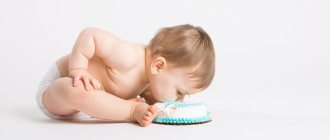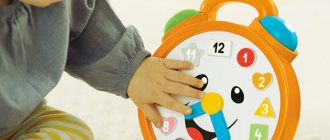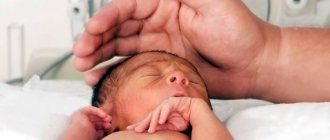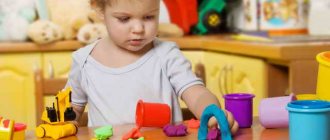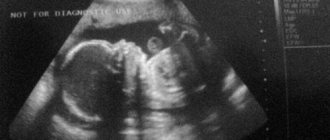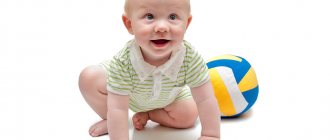Baby skills at 10 months
A 10-month-old baby has an individuality that persistently manifests itself in everything. He is characterized by independence - he can do quite a lot, manifestations of character - he expresses his disagreement or approval in accessible ways, and persistently achieves his goal.
What should a 10 month old child be able to do:
- Coordination of movements is quite developed, so it crawls anywhere and everywhere. All the premises were examined, he visited everywhere on his own;
- If there is any support on the way that you can grab onto, then an attempt is immediately made to stand on your feet;
- The cup and spoon have been mastered and “accustomed to the hands”, although not yet very skillfully and accurately, but when feeding there will definitely be attempts to eat and drink compote on their own;
- At 10 months, the child must be given food from the common table so that he develops his own taste preferences;
- Sometimes you can already understand which hand will be the leading one (right or left), all objects are taken with it;
- The movements of adults are remembered and reproduced: they can open and close drawers, move a chair.
New aspects have appeared in the baby’s mental development:
- imitation is highly developed - repeats syllables after an adult;
- understands jokes, gradually develops his own sense of humor;
- knows how to handle a telephone (or an object similar to it, brings it to the ear as if talking);
- meaningful gestures - waves goodbye, hugs, reaches out when meeting;
- understands and knows the word “impossible” and rejoices when he is praised;
- looks for a hidden object when it is hidden on him, remembers where his toys are.
Baby skills
Babies begin to react to unpleasant situations and harmful objects
But for now, this ability is very individual and manifests itself in different ways, so you shouldn’t particularly count on the “conscious” behavior of the baby. For example, fear of heights. At this age stage, children develop a fear of heights, which is clearly demonstrated by the experiment with a cliff.
Cover the surface of the table with glass, place a bright cloth under it on half the table, and spread another piece of such cloth under the table on the other side. Place the child on the part of the table where the cloth lies, and he will crawl forward. When the baby reaches the edge of this part of the table, his hands continue to rest on the glass, but his eyes “say” that there is an abyss ahead, so the little one stops without crawling to the other half of the table. This experiment proves that babies at this stage of development can determine the edge and height and make a decision: they can’t crawl any further.
Parents should definitely be warned that, despite the described experience and the baby’s reaction, never leave the child to play on the table! In impulsive children, temperament sometimes takes precedence over the awareness of the impending danger, and they may well crawl forward, “over the edge of the abyss.”
Development tests
11 months old baby
Not all babies have developed equally by the tenth month. Some people have more skills and abilities - there are those who have already begun to walk independently. In general, there is a certain list of what a ten-month-old child should be able to do:
- Sit down and stand up independently, holding onto a support.
- Get to the toy by crawling.
- Understand speech addressed to him.
- Attract the attention of parents with the help of gestures, babble, and syllables.
- Repeat elementary syllables (ma, pa, ba, etc.).
- Babbling should be emotionally charged and not monotonous.
Food should be varied. Infants continue to eat breast milk at night and in the morning, the rest of the time - steamed meat and fish dishes, vegetable purees, fermented milk products, casseroles, milk porridges, jelly and berry fruit drinks. Number of meals – 5 times a day. A bottle-fed baby receives infant formula in the morning and at night, otherwise the nutrition is the same.
The daily routine includes sleeping at night for up to 8-10 hours in a row. If a child wakes up at night and asks to eat, the night meal should be maintained. Daytime sleep should consist of two periods, each lasting 2-2.5 hours. Outdoor walks and active games are required.
Despite his fairly advanced age, for the full development of a 10-month-old baby, it is still necessary to be held in his arms. Parental hugs are as important to him now as ever. He already realizes that he can move away (crawl) some distance from his mother, but he still needs her.
Baby tries to eat on his own
What is the degree of trust the child has in his mother?
An interesting variant of the cliff experiment is the situation when children boldly crawl forward through a “visible” abyss if their mother is waiting for them at the other end of the table with a calm face that does not express any fears about this situation. If there is fear on the mother’s face, then the child freezes in place. Summary: Mothers are emotional regulators for children.
The child receives information about how to behave by “reading” it from the mother’s face or by grasping the mother’s attitude towards her signals. Children read absolutely everything on our faces, especially what relates directly to them. If you are constantly in a depressed, irritable state, then the expression that your child sees on your face is one he will probably carry with him for the rest of his life. The face illuminated by a smile that your child sees will also be remembered by him for the rest of his life.
Main indicators of physical development
By 10 months, the babies had significantly increased in height and weight compared to the newborn period, but monthly gains decreased. This is due to the baby's increased activity and energy expenditure on motor skills.
9 months baby
Physical indicators of girls 10 months
| Indicators | Weight, kg | Height, cm | Head circumference, cm | Chest circumference, cm |
| Girls 10 months | 6,7-10,9 | 66,5-76,4 | 41,5-46,9 | 45,2-50,1 |
Physical indicators of boys 10 months
| Indicators | Weight, kg | Height, cm | Head circumference, cm | Chest circumference, cm |
| Boys 10 months | 7,4-11,4 | 68,7-77,9 | 42,9-47,9 | 45,1-51,4 |
The average size of a large fontanel is 12-14 mm. The number of milk teeth is 6-8.
Attention! Deviation in the timing of teething from the norm by six months, as well as teething in any order are absolutely normal phenomena. Medicines that can influence the timing and sequence of teething do not exist in nature, says pediatrician E. Komarovsky.
Physical indicators
We encourage you to new successes
Even if your child cannot cope with the task, do not scold him. This will only lead to tears and will discourage you from getting down to business again for a long time. Look for the positive every time. Do not rush to be upset if you do not have enough patience to listen to the fairy tale to the end. If you have come even a little further than last time, this is already a reason for joy and praise.
Let your child understand that the work he is doing is not a small thing at all, but is very, very important for you and the whole family. This way you will help your son to believe in himself and get rid of the fear of a new activity for him.
Don't forget about your emotional state. Stop focusing on the results of your work. When developing your son, do not try to catch up and overtake the daughter of your neighbors or friends. Remember that your baby is an individual and has every right to develop at his own pace: start using the potty a little later, and drink from a mug a little earlier than his friends in the sandbox.
A table will help you cope with anxiety, where we have collected everything that a 10-month old boy needs to know.
How to help development
A 6 month old child does not sit or crawl
At this age, the child has quite a wide range of opportunities to explore the outside world. Active crawling together with the ability to sit and stand independently significantly expands his space. Moving around the apartment, the child studies the layout of the rooms, remembers which room he sleeps in and where the kitchen is located, and learns to handle toys for their intended purpose. A doll means you need to feed it and put it to bed, a car means it can be rolled on the floor, a ball can be thrown, cubes can be placed on top of each other. The speech of adults becomes understandable to him, at least by intonation and gestures.
Neuropsychic development
- Communicates his biological needs with his voice;
- Among familiar objects and toys, he finds and gives his favorite ones: a bear, a cube, etc.;
- In the game, he performs previously memorized familiar movements (claps his hands, plays “okay”, moves his finger across the palm and bends his fingers - “magpie-white-sided”).
- With his speech he imitates adults, repeating syllables after them;
- When reading familiar poems, he tries to repeat the endings of words.
Motor skills
- Stands independently, without support;
- Shifts his feet, tries to walk while holding onto support;
- Walks holding the hand of an adult;
- Makes imitative movements with his hands;
- Under eye control, inserts fingers into the hole.
Attention! Crawling and walking bring pleasure to the baby. Therefore, it is necessary to choose exercises that will not only strengthen the muscles, but also bring joy to the child.
Place a folded blanket or towel under the belly of a baby lying on the carpet, lift it so that the baby assumes a crawling position, and carry him in this way for short distances, helping him move around the room.
To train the ability to maintain balance, sit the child with his back on his lap. Take turns raising the right and left knees, while spreading the baby’s arms to the sides. This exercise is good to perform with rhythmic music, then the child will bend to the right and left in time with the music.
Rhythmic morning exercises will give you a boost of energy for the whole day: bending over, squats with support, and at the end dancing in your mother’s arms.
Daily conversations with the child, saying out loud the names of objects, toys, body parts stimulate the development and enrichment of vocabulary. At the same time, it is not necessary to speak constantly, without pauses. The speech must be meaningful and appropriate to the situation. For example, when preparing for a swim, the names of the clothes that are taken off are spoken out. In the bath itself, parts of the body (hands, legs, head, ears, nose) that mother soaped, etc. are spoken out.
When feeding a child, you can offer to make a choice between juice and compote, the baby’s reaction will already be conscious. He will choose exactly what he wants at the moment. The best educational activity for the baby will be playing together.
Development at 10 months
Diet
The development and nutrition of a 10-month-old child has its own characteristics. The baby needs five feedings a day. At night, children behave differently: some sleep soundly until the morning, others wake up several times and ask for the breast.
The diet of a child at this age is very similar to that of an adult. But for now it is not recommended to give exotic fruits, pickles, smoked foods, and canned foods. There is no need to puree all dishes. Potatoes, steamed carrots, fruits can be given in pieces.
List of permitted products for children 10 months old:
- porridge (rice, oatmeal, buckwheat);
- bread;
- crackers, biscuits;
- vegetable and meat soups;
- cottage cheese;
- chicken yolk;
- fruits (apples, bananas, pears, apricots);
- cauliflower, zucchini, broccoli, carrots, beets;
- meatballs, chicken, turkey, beef cutlets;
- kefir.
The approximate regime and diet of a ten-month-old baby in the table:
| Time | List and volume of products |
| 6:00 | breast milk or formula (200 ml) |
| 10:00 | rice porridge (200 g), bread (10 g), fruit puree (30 g) |
| 14:00 | vegetable puree (100 g), meat broth soup (50 ml), meatball (40 g), bread (10 g) |
| 18:00 | cottage cheese (40 g), kefir (160 ml), biscuits (10 g) |
| 22:00 | breast milk or formula (200 ml) |
Ten-month-old babies expend a lot of energy by constantly being on the move. To replenish wasted energy and normal development, nutrition must be balanced, complete, and contain the required amount of minerals and vitamins.
Educational and active games
Every day a child's games become more and more meaningful. The usual rolling of a ball gives an idea of the shape of an object - the cube does not roll, it can be moved, pushed, the ball just needs to be pushed with your hand and it will roll. A pyramid (rings of different sizes placed on a vertical axis) becomes a finger trainer. Putting each ring on requires dexterity. The rings on the pyramid are of different colors, so you can study the names of different (primary) colors and find the right ring not only by size, but also by color. Excellent musical instruments are made from kitchen utensils. Pots, lids and ladle turn into percussion instruments. Salted homemade dough or ready-made store-bought play dough will serve as an excellent simulator for fine motor skills.
Important! Since at ten months babies show vigorous activity, they try very hard to learn to walk independently, it is necessary to remember the safety rules. The bed no longer seems like an insurmountable obstacle; you can climb onto it very deftly. Therefore, as soon as the child has learned to climb, it is necessary to show and teach how to descend correctly. It is best to show by personal example how to do it correctly and safely. If your baby is actively getting up in his crib and trying to climb over the railing, it is safer to remove one wall, otherwise he could be seriously injured when he tries to climb over it.
Activity and the desire to constantly move must be properly organized. You can build an obstacle course. Boxes, massage mats, and large foam cubes are useful for this. You can use a ready-made solution: buy a playhouse with a pipe and fill it with plastic balls. Let him crawl with pleasure, sort through colorful balls, make his way, and at the same time strengthen his back muscles.
In addition to the dough, it is good to use kinetic sand, but you should stock up on a sandbox for it in advance. It has slightly different properties compared to dough: it holds its shape, but when pressed it becomes mobile. It’s good to “pour” it from one hand to another or into a sandbox. In addition to fine motor skills, it develops finger sensitivity.
You can keep a boy or little girl busy in the kitchen while mom is preparing dinner by playing “Cinderella.” Pour cereal or pasta into the tray. You can hide a small toy there and ask him to find it. This is how tactile skills develop. Or play with sounds: pour various cereals into Kinder jars and shake them one by one. Excellent development of musical ear is guaranteed.
A small book with thick sheets and bright, large pictures will be very useful. Now the child can turn over the sheets on his own, from the pictures he can learn what animals, plants, cars, dolls, colors, shapes, etc. are. When read aloud by an adult, the child will remember words (memory training), repeat syllables and parts of words (speech development) , correlate the name with the picture (forming an idea of the subject).
Activities and games should not tire the baby, so their duration should be no more than 10-15 minutes a day.
At 10 months, you can and should meet other kids the same age. For full development and education there must be a social component. You can try to implement communication in the sandbox, if it is not crowded, or invite a mother and baby you know to visit. Communication will benefit both toddlers. They will learn new skills from each other, while mothers will take a break over a cup of tea, watching them.
Educational games
Successful development depends on parents. Like no one else, they should be interested in ensuring that both dad and mom have enough time for the child. This does not mean that parents should find the time and money to pay for a subscription to an early childhood development center. You can successfully develop and educate at home. Knowledge of letters and numbers, as well as English for infants, can be postponed for the future. Now the most important thing is physical activity, which needs to be stimulated in every possible way.



